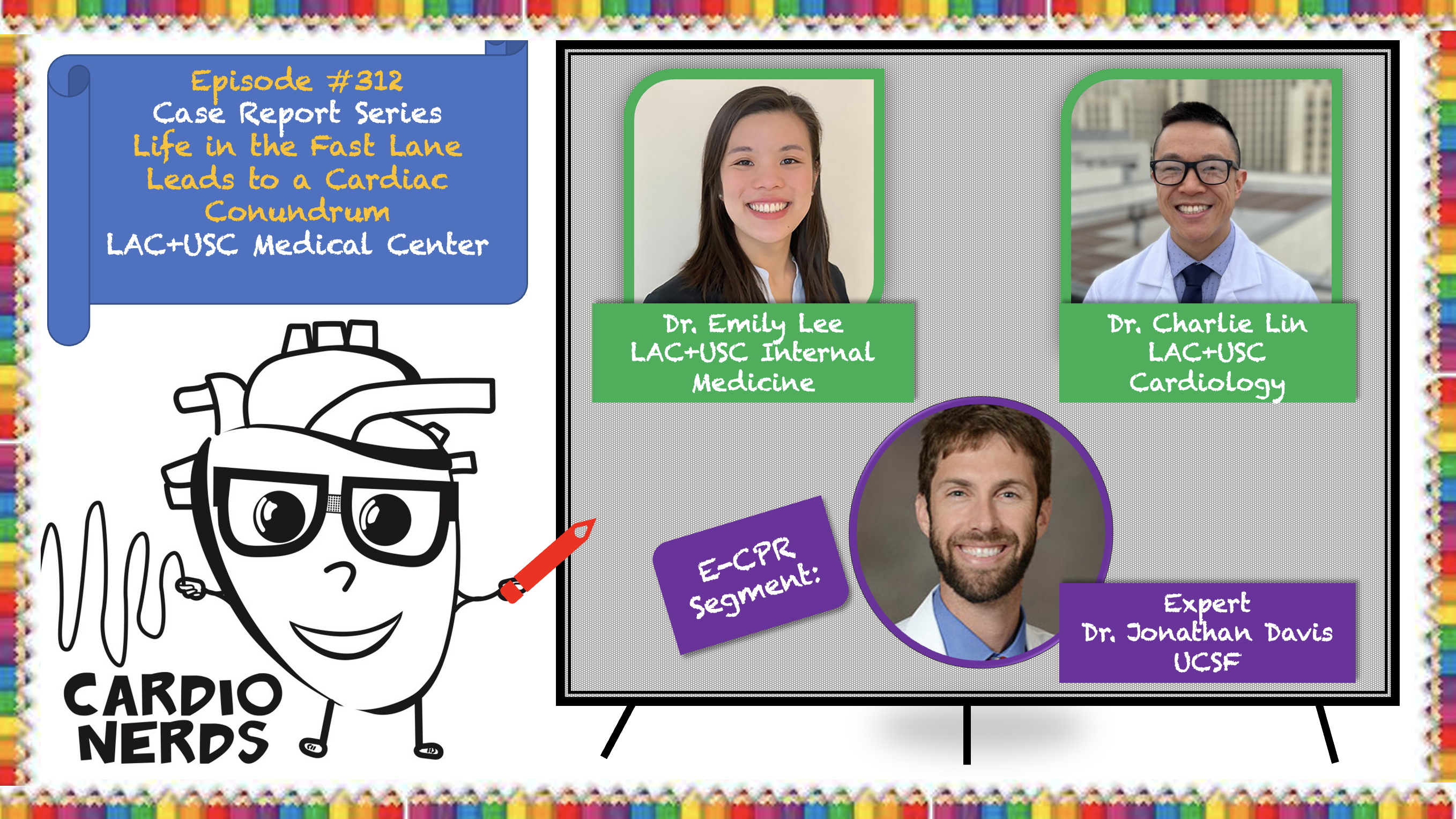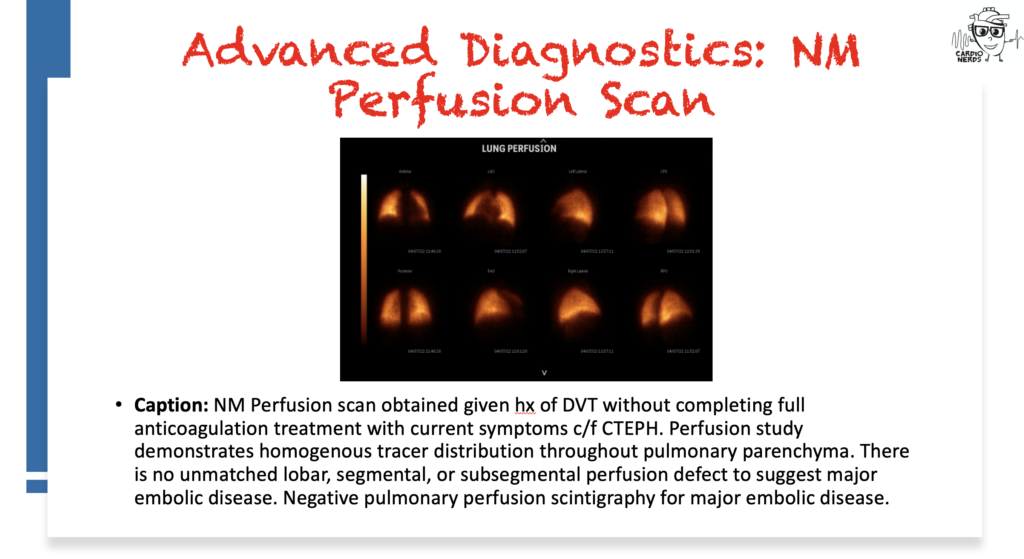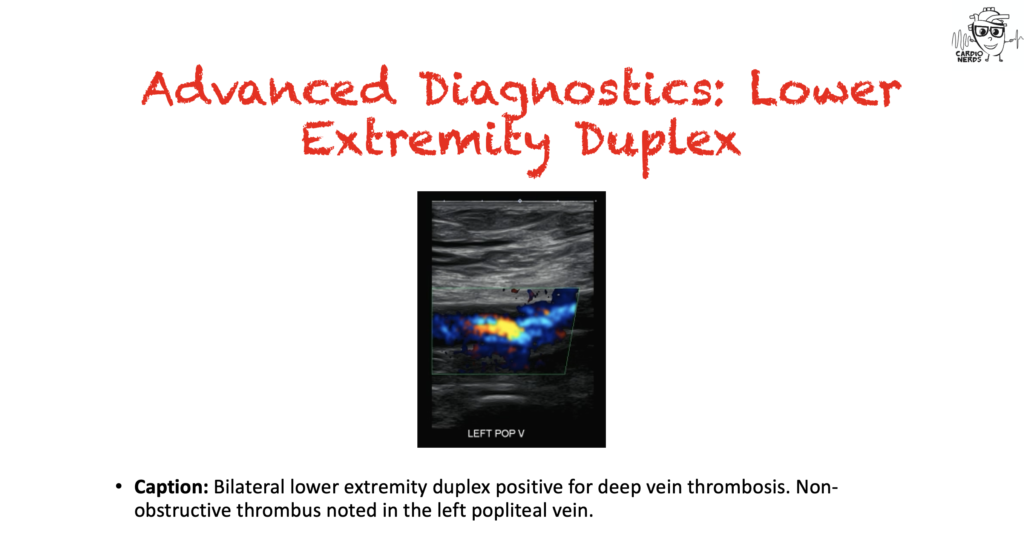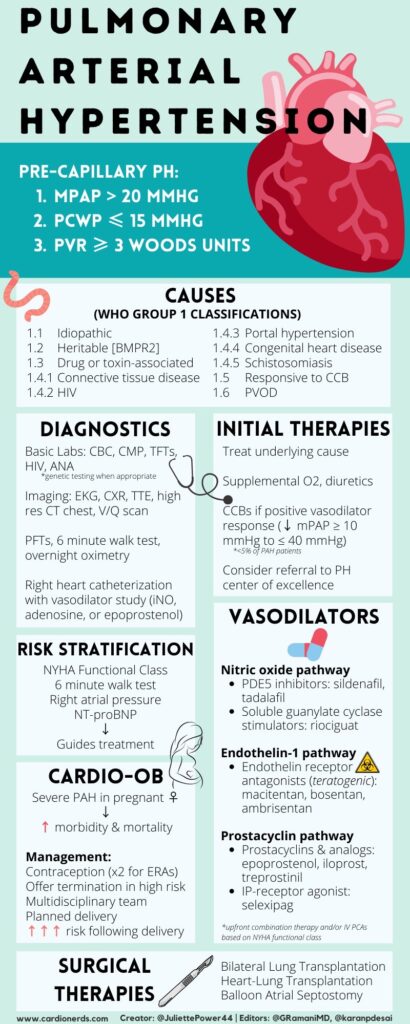Cardionerds: A Cardiology Podcast

312. Case Report: Life in the Fast Lane Leads to a Cardiac Conundrum – Los Angeles County + University of Southern California
CardioNerds (Drs. Amit Goyal and Dan Ambinder) join Dr. Emily Lee (LAC+USC Internal medicine resident) and Dr. Charlie Lin (LAC+USC Cardiology fellow) as the discuss an important case of stimulant-related (methamphetamine) cardiovascular toxicity that manifested in right ventricular dysfunction due to severe pulmonary hypertension. Dr. Jonathan Davis (Director, Heart Failure Program at Zuckerberg San Francisco General Hospital and Trauma Center) provides the ECPR for this episide. Audio editing by CardioNerds Academy Intern, student doctor Akiva Rosenzveig.
With the ongoing methamphetamine epidemic, the incidence of stimulant-related cardiovascular toxicity continues to grow. We discuss the following case: A 36-year-old man was hospitalized for evaluation of dyspnea and volume overload in the setting of previously untreated, provoked deep venous thrombosis. Transthoracic echocardiogram revealed severe right ventricular dysfunction as well as signs of pressure and volume overload. Computed tomography demonstrated a prominent main pulmonary artery and ruled out pulmonary embolism. Right heart catheterization confirmed the presence of pre-capillary pulmonary arterial hypertension without demonstrable vasoreactivity. He was prescribed sildenafil to begin management of methamphetamine-associated cardiomyopathy and right ventricular dysfunction manifesting as severe pre-capillary pulmonary hypertension.
“To study the phenomena of disease without books is to sail an uncharted sea, while to study books without patients is not to go to sea at all.” – Sir William Osler. CardioNerds thank the patients and their loved ones whose stories teach us the Art of Medicine and support our Mission to Democratize Cardiovascular Medicine.
CardioNerds is collaborating with Radcliffe Cardiology and US Cardiology Review journal (USC) for a ‘call for cases’, with the intention to co-publish high impact cardiovascular case reports, subject to double-blind peer review. Case Reports that are accepted in USC journal and published as the version of record (VOR), will also be indexed in Scopus and the Directory of Open Access Journals (DOAJ).

CardioNerds Case Reports Page
CardioNerds Episode Page
CardioNerds Academy
Cardionerds Healy Honor Roll
CardioNerds Journal Club
Subscribe to The Heartbeat Newsletter!
Check out CardioNerds SWAG!
Become a CardioNerds Patron!
Case Media – stimulant-related (methamphetamine) cardiovascular toxicity


Pearls – stimulant-related (methamphetamine) cardiovascular toxicity
1. Methamphetamine, and stimulants in general, can have a multitude of effects on the cardiovascular and pulmonary systems. Effects of methamphetamine are thought to be due to catecholamine toxicity with direct effects on cardiac and vascular tissues. Acutely, methamphetamine can cause vascular constriction and vasospasm, while chronic exposure is associated with endothelial damage. Over time, methamphetamine can cause pulmonary hypertension, atherosclerosis, cardiac arrhythmias, and dilated cardiomyopathy.
2. Methamphetamines are the second most commonly misused substances worldwide after opiates. Patients with methamphetamine-associated pulmonary arterial hypertension (PAH) have more severe pulmonary vascular disease, more dilated and dysfunctional right ventricles, and worse prognoses when compared to patients with idiopathic PAH. Additionally, patients with methamphetamine-associated cardiomyopathy and PAH have significantly worse outcomes and prognoses when compared to those with structurally normal hearts without evidence of PAH. Management includes multidisciplinary support, complete cessation of methamphetamine use, and guideline-directed treatment of PAH.
3. The diagnosis of pulmonary hypertension (PH) begins with the history and physical, followed by confirmatory testing using echocardiography and invasive hemodynamics (right heart catheterization). Initial serological evaluation may include routine biochemical, hematologic, endocrine, hepatic, and infectious testing. Though PH is traditionally diagnosed and confirmed in a two-step, echocardiogram-followed-by-catheterization model, other diagnostics often include electrocardiography, blood gas analysis, spirometry, ventilation/perfusion assessment, CT scans, MRIs, and/or genetic testing to evaluate for the myriad of etiologies that may contribute to the development of PH.
4. PH is characterized by remodeling of the pulmonary vasculature and a progressive increase of pulmonary vascular load, often resulting in right ventricular hypertrophy, remodeling, and dysfunction. PH is defined hemodynamically by a mean pulmonary arterial pressure ≥ 20 mmHg at rest when measured by right heart catheterization (RHC). Pre-capillary pulmonary hypertension due to pulmonary vascular disease is further defined by an elevation in pulmonary vascular resistance (PVR) of at least 3 wood units (WU).
5. Medications used to treat pulmonary arterial hypertension fall into four general mechanistic classes: calcium channel blockers, endothelin receptor antagonists, phosphodiesterase-5 inhibitors, and prostacyclin receptor agonists.
Show Notes – stimulant-related (methamphetamine) cardiovascular toxicity

- How is pulmonary hypertension diagnosed with right heart catheterization (RHC)?
Pulmonary hypertension is defined by mean pulmonary arterial pressure (mPAP) ≥ 20 mmHg at rest. Pulmonary hypertension has three hemodynamic phenotypes – pre-capillary PH, post-capillary PH, and combined pre-/post-capillary PH. Isolated pre-capillary PH is defined by pulmonary vascular resistance (PVR) ≥ 3 woods units and pulmonary artery wedge pressure (PAWP) ≤ 15 mmHg. Isolated post-capillary PH is defined by PVR < 3 woods units and PAWP > 15 mmHg. PVR is calculated by dividing the mean trans-pulmonary gradient (= PAWP – mPAP) by the cardiac output.
Characteristics
Clinical groups
Isolated pre-capillary PH
mPAP >20 mmHg
PAWP ≤ 15 mmHg
PVR ≥ 3 WU
WHO 1,3,4, and 5
Isolated post-capillary PH
mPAP >20 mmHg
PAWP > 15 mmHg
PVR < 3 WU
WHO 2 and 5
Combined pre- & post-capillary PH
mPAP >20 mmHg
PAWP > 15 mmHg
PVR ≥ 3 WU
WHO 2 and 5
Classification of PAH by WHO Groups:
WHO Group 1
Pulmonary Arterial Hypertension
WHO Group 2
Pulmonary hypertension due to left sided heart disease
WHO Group 3
Pulmonary hypertension due to lung disease or hypoxia
WHO Group 4
Chronic thromboembolic pulmonary hypertension and other pulmonary artery obstructions
WHO Group 5
Pulmonary hypertension with multifactorial mechanisms
Idiopathic
Left ventricular systolic and/or diastolic dysfunction
Chronic obstructive pulmonary disease
Chronic thromboembolic pulmonary hypertension
Hematological Disease (Sickle cell disease)
Hereditary
Left-sided valvular heart disease
Interstitial lung disease
Obstruction of the pulmonary circulation by tumor or inflammation
Systemic disorders (Sarcoidosis, Langerhans cell granulomatosis)
Drug and toxin induced
Other mixed restrictive or obstructive lung disease
Metabolic disorders (Gaucher’s disease)
Associated with connective tissue disease
Sleep-disordered breathing
Associated with HIV infection
Alveolar hypoventilation disorders
Associated with portal hypertension
Chronic exposure to high altitude
Congenital heart disease
Schistosomiasis
- What is vasoreactivity testing?
Pulmonary vasoreactivity testing is used to identify patients who may respond favorably to calcium channel blocker (CCB) treatment. Typically, this includes patients with idiopathic pulmonary arterial hypertension, heritable pulmonary arterial hypertension, or substance-related pulmonary arterial hypertension. It is usually performed at the time of RHC. Inhaled nitric oxide (NO) at 10–20 parts per million (ppm) is the standard of care for vasoreactivity testing with alternatives including intravenous adenosine and epoprostenol. A significant response to vasodilator therapy is defined by a reduction of the mean PAP by at least 10 mmHg and concurrent decrement of the absolute value to less than 40 mmHg, without a decrease in cardiac output. Vasoreactive PH should be treated with CCB therapies such as nifedipine, diltiazem, and amlodipine. Vasoreactivity is relatively rare, occurring in 10% or fewer individuals with PH who undergo testing. PH without vasoreactivity of significant response to CCB therapy should be managed with alternative class of medications (see below).
- What is the medical treatment for PAH?
Medication treatment of pulmonary arterial hypertension comes in 4 general categories with the general mechanism is listed:
- Calcium channel blockers (nifedipine, diltiazem and amlodipine used in high doses) – used in patients with positive vasoreactivity testing.
- Endothelin receptor antagonists (ambrisentan, bosentan, macitentan) – inhibit binding of endothelin, a vasoconstrictive peptide, to its receptors on smooth muscle cells, which is enriched in pulmonary vasculature, resulting in vasodilation and subsequent decrease in pulmonary arterial pressure.
- Phosphodiesterase 5 inhibitors and guanylate cyclase stimulators (sildenafil, tadalafil, riociguat) – ihibition of the cyclic guanosine monophosphate (cGMP) degrading enzyme phosphodiesterase type 5 results in vasodilation through the NO/cGMP pathway in the pulmonary vasculature, which contains substantial amounts of this enzyme.
- Prostacyclin analogues and prostacyclin receptor agonists (epoprostenol, iloprost, treprostinil, beraprost) – prostacyclin is produced predominantly by endothelial cells and induces potent vasodilation of all vascular beds and patients with PAH have been shown to have a reduction of prostacyclin synthase expression in the pulmonary arteries.
References –
- Ben-Yehuda O, Siecke N. Crystal Methamphetamine: A Drug and Cardiovascular Epidemic. JACC Heart Fail. Mar 2018;6(3):219-221. doi:10.1016/j.jchf.2018.01.004
- Benza RL, Gomberg-Maitland M, Miller DP, et al. The REVEAL Registry risk score calculator in patients newly diagnosed with pulmonary arterial hypertension. Chest. Feb 2012;141(2):354-362. doi:10.1378/chest.11-0676
- Benza RL, Gomberg-Maitland M, Elliott CG, et al. Predicting Survival in Patients With Pulmonary Arterial Hypertension: The REVEAL Risk Score Calculator 2.0 and Comparison With ESC/ERS-Based Risk Assessment Strategies. Chest. Aug 2019;156(2):323-337. doi:10.1016/j.chest.2019.02.004
- Chin KM, Channick RN, Rubin LJ. Is methamphetamine use associated with idiopathic pulmonary arterial hypertension? Chest. Dec 2006;130(6):1657-63. doi:10.1378/chest.130.6.1657
- Galiè N, Humbert M, Vachiery JL, et al. 2015 ESC/ERS Guidelines for the diagnosis and treatment of pulmonary hypertension: The Joint Task Force for the Diagnosis and Treatment of Pulmonary Hypertension of the European Society of Cardiology (ESC) and the European Respiratory Society (ERS): Endorsed by: Association for European Paediatric and Congenital Cardiology (AEPC), International Society for Heart and Lung Transplantation (ISHLT). Eur Heart J. Jan 1 2016;37(1):67-119. doi:10.1093/eurheartj/ehv317
- Hassoun PM. Pulmonary Arterial Hypertension. N Engl J Med. Dec 16 2021;385(25):2361-2376. doi:10.1056/NEJMra2000348
- Hoeper MM, Humbert M, Souza R, et al. A global view of pulmonary hypertension. Lancet Respir Med. Apr 2016;4(4):306-22. doi:10.1016/s2213-2600(15)00543-3
- Kevil CG, Goeders NE, Woolard MD, et al. Methamphetamine Use and Cardiovascular Disease. Arterioscler Thromb Vasc Biol. Sep 2019;39(9):1739-1746. doi:10.1161/atvbaha.119.312461
- Reddy PKV, Ng TMH, Oh EE, Moady G, Elkayam U. Clinical Characteristics and Management of Methamphetamine-Associated Cardiomyopathy: State-of-the-Art Review. J Am Heart Assoc. Jun 2 2020;9(11):e016704. doi:10.1161/jaha.120.016704
- Zhao SX, Kwong C, Swaminathan A, Gohil A, Crawford MH. Clinical Characteristics and Outcome of Methamphetamine-Associated Pulmonary Arterial Hypertension and Dilated Cardiomyopathy. JACC Heart Fail. Mar 2018;6(3):209-218. doi:10.1016/j.jchf.2017.10.006






 Visit Podcast Website
Visit Podcast Website RSS Podcast Feed
RSS Podcast Feed Subscribe
Subscribe
 Add to MyCast
Add to MyCast